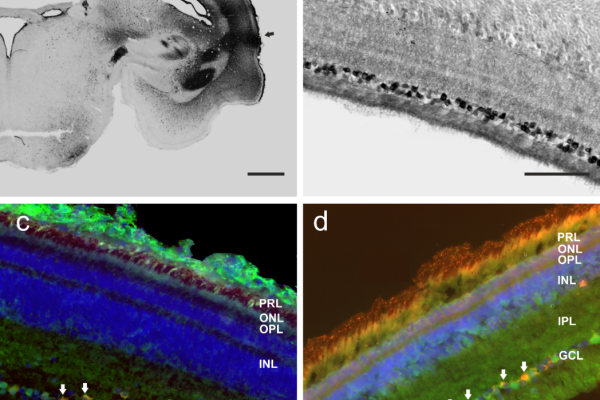2015-11-04

The visual system of adult pigeons shows a lateralization of object discrimination with a left hemispheric dominance on the behavioural, physiological and anatomical levels. The crucial trigger for the establishment of this asymmetry is the position of the embryo inside the egg, which exposes the right eye to light falling through the egg shell. As a result, the right-sided retina is more strongly stimulated with light during embryonic development. However, it is unknown how this embryonic light stimulation is transduced to the brain as the classic photoreceptors, rods and cones, are not yet functional. Scientists from the biopsychology department now identified a photoreceptive protein inside the retina of pigeons which is also expressed during the critical phase of asymmetry induction. This protein, Cryptochrome 1b, is expressed in retinal ganglion cells. A tracing study revealed that such Cryptochrome 1b containing ganglion cells project to the optic tectum, a primary visual area in the pigeon brain. The projection pattern and the presence of Cryptochrome 1b during the critical phase of asymmetry induction suggests that Cryptochrome 1b could indeed be the missing photoreceptive instance responsible for inducing asymmetries in the visual system of pigeons.

The visual system of adult pigeons shows a lateralization of object discrimination with a left hemispheric dominance on the behavioural, physiological and anatomical levels. The crucial trigger for the establishment of this asymmetry is the position of the embryo inside the egg, which exposes the right eye to light falling through the egg shell. As a result, the right-sided retina is more strongly stimulated with light during embryonic development. However, it is unknown how this embryonic light stimulation is transduced to the brain as the classic photoreceptors, rods and cones, are not yet functional. Scientists from the biopsychology department now identified a photoreceptive protein inside the retina of pigeons which is also expressed during the critical phase of asymmetry induction. This protein, Cryptochrome 1b, is expressed in retinal ganglion cells. A tracing study revealed that such Cryptochrome 1b containing ganglion cells project to the optic tectum, a primary visual area in the pigeon brain. The projection pattern and the presence of Cryptochrome 1b during the critical phase of asymmetry induction suggests that Cryptochrome 1b could indeed be the missing photoreceptive instance responsible for inducing asymmetries in the visual system of pigeons.